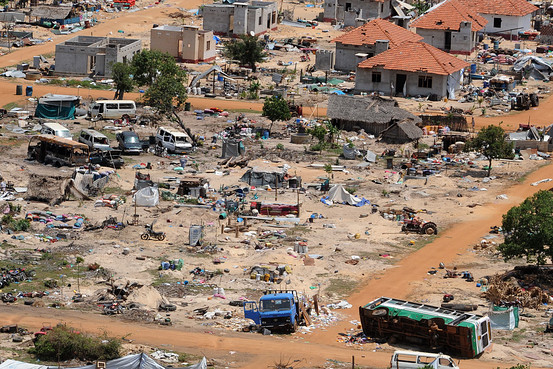Image: Gaza or Mullevaikkal, , Sri Lanka.
“This seems familiar” was the response of many Sri Lankans to the Israeli military action in Gaza initiated in the wake of the appalling 7 October Hamas attack. While every conflict is different, there were – and are – features of the Gazan conflagration that resonate strongly with the final stages of Sri Lanka’s 26-year-long civil war, played out in and around the beaches of the country’s northeast during spring 2009.
First, there is the way in which the conflict itself was described by the authorities. By early 2009 it was clear to most that militarily speaking, the Liberation Tamil Tigers of Eelam (LTTE) had lost the war. LTTE leader Velupillai Prabhakaran steadfastly refused all suggestions of a ceasefire and surrender by his forces. However, fighting continued over the ever-diminishing pocket of land still held by the Tigers, with hundreds of thousands of Tamil civilians trapped in the middle.
In the face of manifest evidence of the resulting carnage, the Government in Colombo held to describing the armed forces’ assault as a ‘humanitarian rescue operation’. And even after the war’s ending in May 2009 with the LTTE’s total annihilation, it continued to hold to this line, even venturing to suggest that zero civilian casualties had occurred in the process.
Updated, the official Israeli version of this approach is to suggest that the twin objectives of continuing military operations in Gaza are to secure the release of the remaining 130 Israeli hostages taken by Hamas and wipe their adversaries out in the process: this in spite of the fact that with much of Gaza reduced to rubble, over 28,000 civilians killed and 67,000 injured, Hamas’ destruction is nowhere in sight.
At what point will these fictions be dropped? If Sri Lankan experience is anything to go by, sadly the answer may be ‘not for some time’. And even then, the belated recognition of reality may be only partial: despite UN and other estimates that between 40,000 and 70,000 Tamil civilians were killed during the final stages of the civil war, official statements continue to hold to a far lower figure. It remains to be seen whether things will be any different in Gaza, where the Israeli authorities remain reluctant to inform their own population of the death toll.
Second, many Sri Lankans react to the way in which the Israeli authorities have regularly instructed Gazan civilians to move to designated ‘safe areas’. All too frequently people have moved as instructed, only to discover that they remain as many potential targets as was the case previously.
This eerily echoes the way in which, during the final stages of the Sri Lankan conflict, the authorities announced a series of ‘No Fire Zones’ (NFZs) within or straddling the borders of LTTE-held territory. In practice, some of the most egregious instances of assaults on civilians occurred precisely following a NFZ establishment. In the first NFZ, announced in late January 2009, for example, its civilian occupants reported that army shelling had only intensified – a development in line with the armed forces’ indiscriminate shelling of makeshift Red Cross-administered hospitals and other ostensibly civilian targets.
Third, and perhaps most significantly, in both cases international powerlessness in the face of civil/intra-state war is palpable. In Sri Lanka, as in Israel, the international community has attempted to mediate an end to the fighting and secure a ceasefire deal. In Sri Lanka’s case, such efforts were mostly met with official rejection. Moreover, the refusal of outside assistance, alongside anything deemed ‘interference’ by the then Rajapaksa Government – with support from Russia and China on the UN Security Council – continued after the war’s end. The lesson drawn by many external actors was, put simply, a clear demonstration of the limits to third-party mediation and intervention in an increasingly multipolar world.
Fourth, 14 years on from the LTTE’s defeat Sri Lanka is no nearer to achieving reconciliation between its majority Sinhalese and minority Tamil populations. Like Sri Lanka before it, the Israeli authorities are engaged in an effort to eradicate an ideology – Palestinian freedom – and subjugate its supporters – ordinary Palestinians. And in both cases, however successful the military venture involved may prove its political component – a peace deal based on principles acceptable to both sides – remains out of reach. Like Sri Lanka, Israel needs to understand that without a (reasonably) just peace, ultimately there will be no lasting peace at all.
Finally, and related, whatever happened to the Responsibility to Protect (R2P) doctrine that under-pinned international interventions in, for example, Sierra Leone, Bosnia-Herzegovina and Kosovo? Discredited by the invasions of Iraq and Afghanistan is the standard answer. Yet the question remains: in Gaza today, as in Sri Lanka and Syria previously, is the international community unable – or simply unwilling – to intervene to prevent large-scale civilian suffering in the manner envisaged by R2P? If the answer is ‘yes’, honesty demands that both Gazans and future fellow-sufferers are informed of this fact. And if ‘no’, in Lenin’s words the question remains: what is to be done?
(The writer is an analyst. He is the author of “To End A Civil War: Norway’s Peace Engagement in Sri Lanka” (Hurst, 2015). He could be reached via email at [email protected].)
Courtesy of Daily FT
